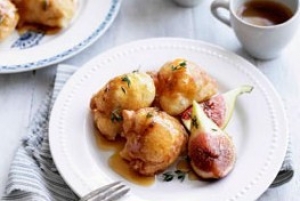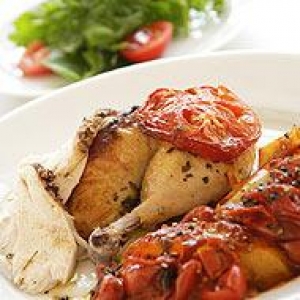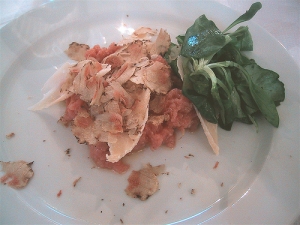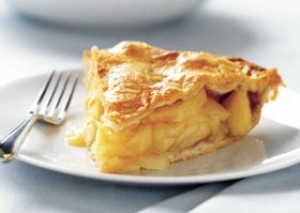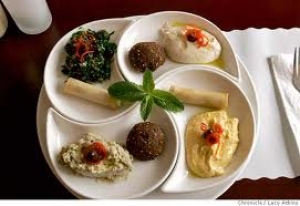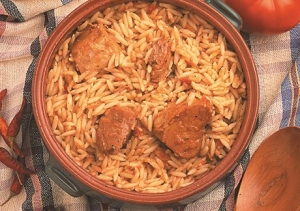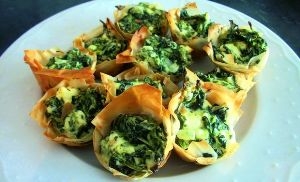Greek cooks give loukoumades their distinctive shape by squeezing the very soft dough through their hands into the hot oil and turning the dough while it cooks until it is puffed and golden. Be very careful doing this as the hot oil may spit and there has been the odd report of an exploding loukoumada. Drain them on absorbent paper, drizzle them with honey – single-blossom is good for added flavour and fragrance – and scatter them with ground cinnamon for the traditional version of this luscious dish. Don’t stand on ceremony, either, waiting for the whole batch to cook. These little golden beauties are best served as hot as you can handle.
We’ve glammed our loukoumades up with wedges of photogenic (and tasty) figs and fragrant thyme leaves, but at their heart they remain the essence of simplicity. Simple, perhaps, but we’re betting you won’t be able to stop at one (or even two).
Ingredients
14 gr (about 2 sachets) dried yeast
300 gr (2 cups) plain flour, sieved
For deep-frying: vegetable oil
10 black figs, quartered
Honey and thyme syrup
360 gr (1 cup) Attiki or other Greek honey
110 gr (½ cup) sugar
1 lemon, thinly peeled rind and juice only
2 tbsp thyme leaves, plus extra to serve
METHOD
1. Combine yeast and 250ml warm water ina large bowl, stir to combine, then add 75gm flour, stir and set aside until foamy (5-7 minutes). Add remaining flour, 250ml warm water and a pinch of salt and beat with a wooden spoon until smooth and elastic. Cover and set aside until doubled in size (1-1½ hours).
2. Meanwhile, for honey and thyme syrup, combine honey, sugar, rind, juice and 125ml water in a small saucepan over medium heat, stir until sugar dissolves (3-5 minutes), then simmer until slightly reduced and syrupy (5-7 minutes). Remove from heat, cool slightly, add thyme leaves and set aside to cool to room temperature.
3. Meanwhile, heat vegetable oil in a deep-fryer or deep-sided frying pan to 180C. Spoon tablespoons of batter into oil, or squeeze them through your hands (be careful as hot oil may spit), and turn occasionally until golden and cooked through (3-4 minutes). Remove with a slotted spoon, drain on absorbent paper. Serve warm with figs, drizzled with syrup and scattered with extra thyme.
Note This recipe comes courtesy of Mary Loucas, mother of GT editor Anthea Loucas and is from the March 2010 issue of Australian Gourmet Traveller.
Serves 10
Cooking Time Prep time 20 mins, cook 25 mins (plus proving, cooling)
WORDS Emma Knowles RECIPE Alice Storey and Mary Loucas PHOTOGRAPHY Ben Dearnley STYLING Geraldine Munoz and Alice Storey
For more information, please visit Gourmettraveller.com.au
ABOUT US
XpatAthens
Delicious Loukoumades
The simplest things in life are often the best. Clichéd? Of course, but also quite often true. Take these classic loukoumades, for example. Their name sounds pretty exotic, but when you break them down, they’re nothing more than little balls of fried dough. Now don’t get us wrong, we love little balls of fried dough (and so do many other people if their proliferation in many cultures is anything to go by – doughnuts, churros or beignets, anyone?). But there’s not much to them: flour, yeast and water, sometimes a pinch of sugar or a drizzle of oil or melted butter. Easy peasy.
Cypriot Oregano And Cinnamon Roast Chicken
Tonia Buxton's succulent roast chicken is cooked Cypriot-style with onions, tomatoes and wonderfully fragrant herbs and spices.
Ingredients
1 chicken, weighing about 1.4kg
2 tbsp extra virgin olive oil
1 large buffalo tomato, sliced into 8 segments
1 large onion, sliced horizontally
2 tsp chopped oregano
2 tsp ground cinnamon
freshly ground salt and black pepper
cumin potatoes, to serve
For the village salad:
large bunch of coriander, trimmed and chopped
large bunch of flat leaf parsley, trimmed and chopped
large handful of Greek rocket
6 cherry tomatoes, chopped
sea salt
splash of extra virgin olive oil
squeeze of lemon juice
Method
1. Preheat the oven to 180°C.
2. Place the chicken in a roasting pan. Rub with 1 tablespoon of the olive oil.
3. Arrange the tomato segments on the breast and legs. Split the onion rings and place all around the chicken
4. Sprinkle with the oregano and cinnamon, and salt and pepper.
5. Drizzle the remaining olive oil over the chicken. Roast for 1 hour and 30 minutes or until the juices from the thickest part of the thigh run clear when pierced.
6. Transfer to a warm serving dish and leave to rest for 10 minutes in a warm place.
7. To make the salad, combine the coriander, parsley, rocket and tomatoes in a serving bowl. Sprinkle with salt and just enough oil to coat the leaves. Toss briefly, then add a squeeze of lemon juice and toss again.
8. Serve the chicken with the salad and Cumin Potatoes.
Surprising Ways To Cook With Greek Yogurt
This wonder ingredient goes way beyond breakfast, to cooling off spicy dishes, keeping burgers juicy and even helping you make a last-minute cake.
A Light -- But Still Creamy -- Mac 'n' Cheese
Sure, you can make swaps to turn this classic comfort-food dish into a healthy dinner, but if you go too far -- e.g., using fat-free cheese, or a butter alternative -- you may sacrifice the richness. Greek yogurt, though, ensures a finished casserole that's just as thick and filling as traditional versions. Recipe
Cupcakes (or Cake) Without Any Fancy Ingredients
The two-ingredient yogurt cake recipe we've been seeing all over Pinterest (just add cake mix!) certainly sounds intriguing. Even if you're skeptical, though, it does drive home the point that if you've got yogurt, you can probably make a cake. (The same holds true for sour cream, but these days, fridges are more likely to contain a tub of plain Greek yogurt than a tub of sour cream.) Adding a cup of yogurt yields a cake that's moist and keeps well for days. Recipe
A Cool Counterpoint To Spicy Soup
We're totally stealing this recipe's trick for taming the heat on a hot soup: You thin plain Greek yogurt with water (use three parts yogurt and one part water), and then drizzle it over whatever you're eating. In this case, it's a curried (and cayenne-d) Indian lentil and chickpea stew, but the technique would work great with chili, too. Recipe
Healthy Burgers That Stay Juicy
Turkey burgers are such a wonderful alternative to burgers made with fattier meats, but all too often they're dry and crumbly. The fix: a quarter-cup of Greek yogurt (for a pound and a half of meat). It's better for you than eggs, and couldn't be easier: just gently mix it into the meat before forming the patties. Recipe
A Dipping Sauce That Goes With Practically Anything
O mag food columnist Sunny Anderson likes to dip fried green tomatillos into this sweet and spicy mix of Greek yogurt, sour cream, honey and hot sauce -- but the creamy accompaniment has tons more uses. Try it on a BLT instead of mayo, with quesadillas or alongside appetizers from potato skins to chicken fingers. Recipe
By Lynn Andriani
Skordalia - The Greek Garlic Dip
Skordalia, the Greek garlic dip, belongs to the grand tradition of Mediterranean garlic pastes and like them, it is almost never served alone; instead, it plays an accompanying role to fried fish and seafood or to classics like boiled beets.
While there are as many methods for frying salt cod as there are cooks who fry it, skordalia variations tend to follow a regional vein. I have always been impressed by the wealth of regional expressions when it comes to this simple peasant dish, as well as to the ritual that often goes into its preparation.
Garlic, olive oil, and salt are the constants in all Greek skordalia recipes, but the base, acid, and consistency vary from place to place. Dried bread, boiled potatoes, and nuts, especially almonds, pine nuts or walnuts, may all be used as the base of this pungent specialty, either alone or together with stale bread or potatoes. One recipe, from the Peloponnese, calls for starchy chestnuts. Fresh lemon juice, fish stock or broth, and vinegar are the liquids that help balance the final flavors. At least one version, a traditional recipe of the Asia Minor Greeks, calls for pistachios; the skordalia of Nea Marmara in Halkidiki is made with feta and mint; one delicious, obscure recipe popular in the traditional shepherd’s cooking of the Greeks who came to Greece from the Black Sea, is made with almonds, yogurt and vinegar.
Connoisseurs of skordalia know that a certain ritual is part and practice of its preparation. I will never forget once walking in on an old caterer friend who was making skordalia for a party—by hand, potato by potato, drop by drop of olive oil, pinch by pinch of salt, in a mortar, pounding each potato with the pestle with zenlike rhythm. To this day, the mortar and pestle are the best tools for making skordalia because they allow for the control of speed with which one breaks down the starch in the potatoes or bread that most commonly make up the base. A food processor’s blade is too swift and violent and results in a gummy skordalia. Unless the potatoes are cold, which is the advice of the family fry master, who, between dipping chunks of salt cod in his secret batter and frying them with the patience of Jove, he also sometimes takes a stand near the mixer, making the dish in question. Cold potatoes don’t break down as easily, it turns out, as hot ones. But they also don’t absorb oil as easily.
Aliada
In the Ionian islands, skordalia is called aliada, clearly an Italian sounding word and once that evinces vincing the influence that 200 hundred or so years of Venetian administration over these islands brought to their cookery.
Perhaps nowhere is the certainty of ritual more obvious than in the old cooks of Cephalonia, where the island’s aliada is made with rules developed over centuries. Mortar and pestle are de rigueur, the vessel and mechanism by which the first steps in the making of skordalia are taken as the cook pounds garlic cloves and salt to a smooth paste. In a separate plate, traditionally made of wood or fired clay, she mashes boiled potatoes either with the pestle or with a fist-sized smooth stone. A pot nearby contains salt cod that’s been soaked and is now simmering to further desalt it. Its broth provides the gustatory undertones and depth of flavor in the final aliada and is added to the garlic and salt, to be followed by a few spoonfuls of partially mashed potatoes. Slowly, step by step and increment by increment, each of these ingredients is wedded to the final, smooth and silky potato-based aliada which is partnered with crispy fried salt cod or other small, fried fish.
By Diane Kochilas
It's Truffle Time At "Sale e Pepe" In Kolonaki
It's the season for white truffles and one of the best restaurants to samples these delicacies in Athens is Sale e Pepe in Kolonaki. The restaurant serves Italian food which focuses on serving seasonal specialities. The owner Ivan Ottaviani, is a big wine lover and the restaurant has one of the best wine lists in Athens with a focus on Italian wines. The service is extremely friendly however prices are on the high side (apetizers 15-20 Euros, main dish around 30Euros, cheese and desert around 20 Euros). White truffle dishes cost approximately 50 Euros.
Wonderful restaurant with a very nice view of the Acropolis (which is more subtle than Orizontes).Sale e Pepe has a tasting menu available for a minimum of 2 persons. Nice wine selection but you may be pushed to buy Grecian wine by the sommelier.
Sale e Pepe, Tel 210-7234102, address 34 Aristippou Street - Kolonaki
Review: It was a Friday afternoon and friends suggested we go out to dinner. After discussing some potential restaurant choices we decided to book at Sale e Pepe in the Kolonaki area of central Athens. An out-of-the-way Italian restaurant, housed on a narrow street on the slopes of the Lycabettus; where parking is typically a nightmare.
I knew Sale e Pepe from Mykonos: a very small but pleasant restaurant that served tasty Italian food with a slight twist. Prices were a bit steep, but being in Mykonos, over-inflated prices compared to Athens is the norm. I remembered at that moment that Sale e Pepe in Mykonos had closed down a few years back but had not learnt why.
We arrived fifteen minutes late as Athens was under a sheet of rain. Walking in, two 30-something aged women took our coats and seated us. I had the impression that the waitresses were overacting, something common in the US but not in Greece. They gave me the feeling of having had stepped out of “Interview of a Vampire”, seemingly ready to suck our blood. My worst fears were later confirmed, although I did give them the benefit of the doubt for perhaps trying to play their role in the setting of the space they were at. The restaurant was dark. The look was that of a gentrified German autobahn stop. But again, laden with cupboards full of wine on display, the stale smell possibly attributed to its all-surrounding wooden interior, I considered that perhaps I was being too harsh with my first impressions.
So now we were seated. Having heard us conversing in English, they offered us an English menu. A thoughtful touch. We held onto both the Greek and English menus. We like to compare for fun. A 100-page wine “Encyclopaedia” was handed to us, to complement the culinary adventure we were unknowingly about to embark on. The extensive list included wines from Spain, France, Italy, Greece… Lebanon - all with a very expensive price tag. I immediately felt awkward. I was the one who had to choose. I then understood the restaurant’s focus is wine, as a way of complementing the rich Northern Italian tastes it offers. Having narrowed down to a short list, we went down the safe path of ordering a Brunelo from Tuscany, at 60 euro a bottle. It made us reminisce back on a pleasant road-trip a few years ago in the like-named Italian province. The waitress couldn’t help herself from remarking that one of our three pre-selected wines would be better revisited in a few years… at that time I knew we were in trouble! I could also not help at that point but have felt a little uneasy and frankly a little irritated at having been ‘told off’ for not being quite the connoisseur she so clearly wanted us to know she was.
The menu was not so complicated in presentation as much as in content… Loads of venison, wild duck, quail eggs, cod (written cold in the English menu), accompanied by pasta and fruity tastes. My stomach started making strange noises. We were all puzzled with the combinations so it took us a good long while to select the most appropriate dish to each of us. I finally ordered the risotto with Tuscan sausage and leeks. Whilst I liked that the restaurant offered more eclectic Italian tastes unlike the classic pizza, spaghetti, mozzarella, the prices on the menu were frightful.
The final couple we were waiting to join us was late. We were hungry and asked for some bread to fill in time. Our waitress took that opportunity to jump on us by rather assertively suggesting a cheese platter. A two minute explanation followed. We had the four types of aged cheeses explained to us. There was also a plate with finely carved and truly very tasty St. Danielle prosciutto on the menu which we asked for. It was served with two poached eggs and black truffle shavings. Both plates were rich tasting enough to avert us from choosing any additional starters.
As the main courses arrived, the plates were small portioned, as should be for a four course menu, but substantial in taste.
One of us ordered a starter salad as a main course. The menu read “cuttlefish and langoustine salad with crispy vegetables”. We asked what crispy vegetables meant and were told that they were lightly sautéed and then corrected to them being marinated. In fact they consisted of one tuft of plain boiled broccoli, one of cauliflower and half a carrot. The single langoustine turned out to be a shrimp – not even king prawn – again plainly boiled and unseasoned, and the cuttlefish was mediocre in that the olive oil it was covered in was truly tasty.
The gentleman across from me ordered venison with parpardele. Half way through the meal, his eyes rolled as he gasped that the dish was too rich for him. I had a taste and instantly flashed back to a road-kill story in New England. The venison stank!
In all honesty my risotto was ok, cooked properly al-dente, but at around 30 euros a serving I expected something even slightly more sophisticated. The remaining dishes I would say were all simply decent, without much to rave about.
I was tired and getting a little restless with the whole experience, knowing that I wouldn’t be able to sleep well in the next few hours. My stomach had already started to feel like the financial market - in crisis.
As some wanted to end the night on a sweet note, we ordered desserts: a sweet crepe with cheese and a tarte tatin. Our waitress, in her classic mode, also pushed an assortment of three chocolate desserts on us. They were all pleasant in appearance but dissatisfying in taste. The crepe was squishy, the tarte was soggy. Of the three chocolate dishes, the chocolate soufflé was overcooked and reminded me of my puppy’s excrement I recently scooped up, the chocolate pyramid covered in granules of rock salt was just plainly bizarre and the chocolate cube with orange syrup was simply boring.
And finally time to pay! Our waitress was happy to remark that the Lemoncelo shots were on the house! At 110 euro per person (around $150)… I wondered what this restaurant’s strategy was: considering that we are in time of financial crisis, the restaurant was 10% full on a Friday night and prices where totally off compared to the tastes provided.
Overall I would recommend this restaurant to wine lovers alone who might wish to accompany their selection with a cheese or meat platter. Beware and be prepared when venturing down to main course and please make sure you eat early and you arrive on a very! empty stomach.
www.stafida.gr
How To Bake The Best Apple Pie
Nothing is more quintessentially fall than apple picking, and there’s no better use of apples than in a buttery, flaky apple pie (though a crisp cider comes close). Toronto’s the Pie Shack, with three locations in the city, sells hundreds of slices a day, all made by Norma Costas and Shane Walker’s Riverside Foods. Here, Walker, who estimates the partners have made close to 20,000 pies since opening in 2008, gives the secrets to baking the best apple pie.
Pick the right apple
“You can buy apples year-round, but it’s much better to buy in-season apples. Right now, we use Cortland and Jonagold or sometimes even Granny Smith. Empires will be out soon and they are also a good baking apple. You want an apple that is both tart and sweet, as they will give the pie the best flavour. An apple like Red Delicious isn’t as flavourful when baked and tends to fall apart.”
Keep the filling simple
“To let the flavour of the apples come through, we keep the filling very simple: just cinnamon, sugar and flour. If you want to get fancier, you can add some of the earthier spices, like vanilla, nutmeg or allspice. But always make sure to only peel the apples right before use, so they don’t get brown before you start baking.”
Handle it as little as possible
“There’s really only two components to an apple pie: the crust and the filling. The filling is the easiest part; where it gets trickier is the pastry – pastry can intimidate people. It’s better to throw out an overworked crust and start again than to have a pastry that is tough. A 1/4 cup of water should be enough to bring the dough together, then start adding it by the tablespoon if it isn’t forming a loose ball.”
Butter is better
“You can use lard, shortening, butter, oil or some combination of the above for the fat for your crust, but we have found that an all-butter crust is what works best. The dough may not be as tender as with shortening or lard, but we’ve found butter imparts the best flavour to the dough.”
The secret ingredient
“One surprising ingredient we sometimes use in our pastry is white vinegar. Just a tiny splash, 3/4 tablespoon, won’t impart any flavour, but it does help tenderize the dough. It makes the final product a little less crunchy and the pastry … softer.”
Two baking temperatures ensure everything is cooked:
“First, cook the pie at a high heat (between 400 F and 425 F) for about 15-20 minutes to get the pastry nice and flakey. Then, to make sure the filling is cooked, lower the temperature to 350-375 F and bake for another 15-20 minutes. If you want the apples softer, you can cook it for up to 40 minutes, but you have to watch the crust. If it starts to brown (or burn) too much, cover it with foil or parchment paper.”
By Fraser Abe
How to Assemble a Meze Platter
The Meze platter should offer a variety of foods, textures, colors, and flavors for people to nibble on as they enjoy wine or ouzo and the company of friends. As a general rule, ouzo and tsipouro go best with seafood meze platters, while wines are a better match for cured meats and cheeses.
Vegetables meze items, such as baked giant beans, eggplants preserved in olive oil, roasted red Florina peppers in brine, olives, capers, and the range of Greek spreads, from roasted eggplant to taramosalata (fish roe puree) and tzatziki (yogurt-garlic-cucumber), can pair up on either platter or can stand separately on their own.
Here are three basic ideas for meze platters:
For red wines: Greek yellow cheeses, such as aged kasseri, kasseri, graviera, kefalograviera, kefalotyri, smoked cheeses, herb-infused cheeses. Mild white cheeses such as manouri. Any of the cured meats that make up the Greek charcuterie tradition, including Lefkada salami, singlino Manis, and dried sausages. Roasted red peppers, sun-dried tomatoes, roasted eggplant spreads, all go well on this platter. Kalamata olive puree, preferably on bread or crackers are a good match, too.
To read more, please visit dianekochilas.com
By Diane Kochilas
Greek Beetroot And Yoghurt Salad
This salad is one of my favorites, a change from eating plain boiled beetroot, seasoned with salt, vinegar and olive oil, the way we usually eat it in Greece. It can serve nicely in a buffet dinner or on your everyday dinner table. Seasoning and quantities depend on individual tastes.
Ingredients
Serves: 8
500g beetroots
250g Greek yoghurt
2 tablespoons red wine vinegar
2 cloves garlic, crushed
salt and pepper
2 teaspoons virgin olive oil
1 heaped tablespoon coarsely chopped walnuts
half walnuts for garnishing
Method
Prep:5min › Cook:30min › Extra time:1hr chilling › Ready in:1hr35min
Scrub and wash beetroots thouroughly under running water.
Put into pan with enough water to cover them and boil in medium heat for 30 minutes or until they are tender.
Rinse under cold water, peel (now the skin comes out easily with just a little squeeze of your fingers). Cut into slices, cubes, whatever you like.
Prepare yoghurt: in a bowl blend yoghurt, vinegar, garlic, salt and pepper and half the olive oil. Add the beetroots and the chopped walnuts in the yoghurt mix, reserving a few pieces of beetroot for garnishing.
Place salad in bowl. Decorate it with pieces of beetroot and walnut halves and drizzle with the rest of the virgin olive oil.
Tip: You can omit the yoghurt and walnuts and serve beetroots with salt, vinegar, olive oil and finely chopped garlic.
By Maroula
Chicken With Orzo - Kotopoulo Yiouvetsi
Ingredients
1.5kg chicken, cut into portions
1 teacup olive oil
640g fresh tomatoes
500g orzo/risoni
1 teaspoon dried oregano
salt and pepper
water
Preparation
Wash and clean the chicken.
Cut into portions and sprinkle salt and pepper over the chicken.
In a large baking tray add plenty of olive oil, you may need to add more than 1 teacup depending on the size of your tray.
Grate the tomatoes over a bowl and keep.
In the tray add the chicken, and 1/3 of the tomatoes and mix all in.
Put in the oven on a medium heat and roast until the chicken is cooked.
Take the tray out of the oven and remove the chicken.
Add the rest of the tomatoes to the tray along with the orzo, 4-5 teacups of boiling water, oregano and salt to season.
Stir through.
Replace the chicken in the tray and return the tray to the oven.
Keep a check on this and give it a stir regularly to make sure the pasta doesn't stick to the bottom of the pan and also that the liquid doesn't dry up. If it does, add some more water, a little at a time, until the pasta is cooked. Be careful not to overcook the pasta.
The orzo should be coated in a rich tomato sauce with just a little runny sauce left over.
Serve with graviera cheese and a spring green salad.
You can adjust this meal to use beef or lamb instead of chicken. It is served in Greece with all meats. If using lamb, use a very lean piece and cut off all visible fat.
This recipe can be cooked in a large casserole saucepan on the stovetop. It is suited more to chicken and is ideal for smaller quantities. You will probably need to add a little water to the chicken in the beginning and let it simmer until cooked.
When you add the pasta, check the water levels, and stir often as it is more likely to stick on the stovetop, regulate the heat to low to not burn.
Source: Ultimate-guide-to-greek-food.com
The Best Spanakopita Recipe
If the phyllo pastry doesn’t melt in your mouth, the filling of spinach and ricotta cheese surely will.
Ingredients
60 ml olive oil
1 onion, finely chopped
1 bunch shallots (spring onions), finely chopped
2 garlic cloves, crushed
1.2 kg baby spinach
2 tbsp chopped dill
250 gm feta cheese, crumbled
150 gm full-fat ricotta cheese
3 tbsp grated parmesan cheese
4 eggs, lightly beaten
½ tsp grated nutmeg
12 sheets phyllo (filo) pastry
120 gm butter, melted
For phyllo pastry
200 gm unbleached flour
A pinch of salt
7 tbsp water, plus more if needed
2 tbsp vegetable oil, plus additional for coating the dough
½ tsp cider vinegar
Preparation:
Combine the flour and salt. Mix the water, oil and vinegar in a measuring cup. Add this mixture to the flour and knead the dough till soft. Make sure it is not too dry, add a little more water if necessary. Knead for about 2 minutes. Pick up the dough and throw it down hard onto your working surface occasionally.
Shape the dough into a ball and transfer it to a plate. Oil the top of the dough ball lightly. Cover the ball tightly with plastic wrap. Allow to stand for 30-90 minutes.
Flour well and roll it out as much as you can. Pick the dough up by holding it by an edge. This way the weight of the dough and gravity can help stretching it as it hangs. Using the back of your hands to gently stretch and pull the dough. You can use your forearms to support it.
Put it on your work surface. Leave the thicker edge of the dough to hang over the edge of the table. Place your hands underneath the dough and stretch and pull the dough thinner using the backs of your hands. Cut out 12 sheets of 15cm x 15 cm measurement.
Heat oil in a frying pan. Add onion, shallots and garlic. Cook for 1 minute until softened, then add spinach and half the dill. Cook, stirring, over low heat for 1-2 minutes or until spinach has wilted. Drain in a colander and cool, then combine with cheeses, egg, nutmeg, salt and pepper.
Preheat oven to 180°C. Brush a 2 ½ litre baking dish with butter. Lay one sheet of phyllo on base and sides and brush with butter. Repeat with 5 more sheets. Spread cheese mixture over top. You can make this dish by layering it like a puff or using the filling in samosa-shaped pastries. Cover with remaining phyllo, brushing each sheet with butter. Trim excess pastry with kitchen scissors and tuck edges into sides of dish. Brush top with butter and score in diamond patterns.
Bake for 45 minutes or until golden. Rest for 10 minutes. Warm remaining butter, add remaining dill and, when serving, pour over sliced spanakopita.
To read more, please visit deccanchronicle.com

